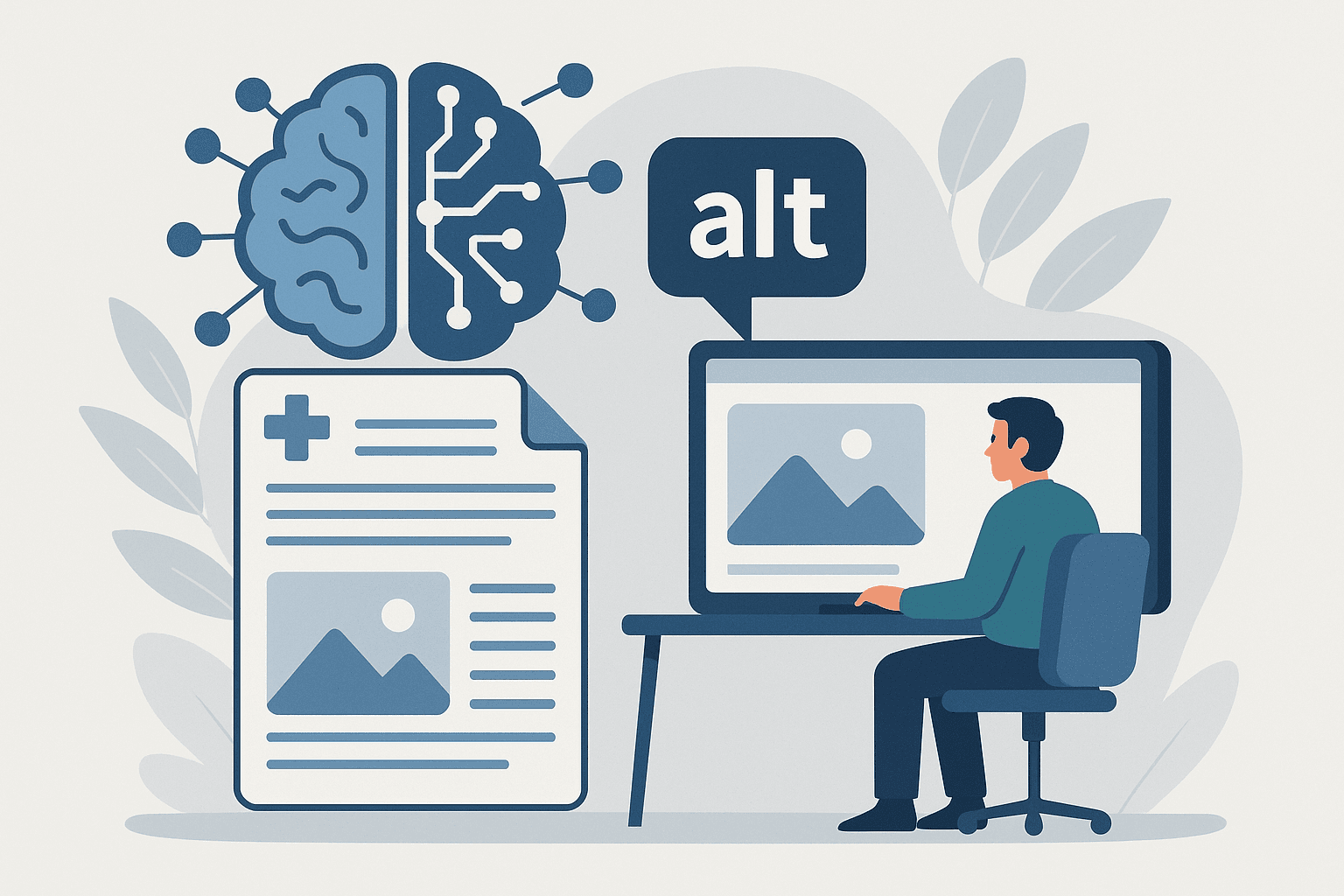Alternative text or “alt text” may seem like a small detail in the vast digital landscape, yet its absence can create insurmountable barriers for millions of users navigating healthcare websites. For individuals with visual impairments, the omission of meaningful image descriptions can mean the difference between informed engagement and exclusion from critical health information. Despite guidelines under the Web Content Accessibility Guidelines (WCAG), studies indicate that nearly 96% of websites fail to meet accessibility standards, and over half of them lack alt text altogether. This problem is especially acute in healthcare, where digital content isn't just informative, it’s often life-impacting.
In an age of rapid digital transformation, artificial intelligence offers a promising solution to this accessibility crisis. However, as our recent study demonstrates, the key to unlocking AI’s potential in alt text generation lies in automation and the thoughtful integration of context.
Why Alt Text Matters in Healthcare
Alt text serves two primary purposes. First and foremost, it ensures accessibility by allowing screen reader users to interpret visual content through text. This is essential for the estimated 2.2 billion people globally who experience some form of vision impairment. In a healthcare setting, where images often carry medical, educational, or procedural significance, omitting alt text deprives users of essential context. A visual of a treatment regimen, a diagnostic chart, or a physician profile isn’t merely decorative – it’s informative.
Second, alt text enhances SEO performance. Proper descriptions improve search engine indexing, elevate image visibility, and can boost organic click-through rates. Yet many organizations, even those with significant resources, neglect this dual benefit
The Challenge of Manual Implementation
Developing meaningful alt text is deceptively difficult. It demands a nuanced understanding of both image content and the broader context in which it appears. Content creators often face time constraints, varying levels of accessibility literacy, and inconsistent application across teams. In healthcare, where the content must also meet clinical accuracy standards, the task becomes even more daunting.
This is where artificial intelligence, huge language models, can play a transformative role.
The Study: Context Is Key
Our research examined how AI could be used to generate alt text across ten major healthcare-related websites, including the CDC, NIH, Mayo Clinic, and WebMD. From each site, we sampled up to five prominent images and tested two approaches: generating alt text with no surrounding context, and generating it with up to 1500 characters of relevant page text pulled from the image’s HTML container and neighboring elements.
AI-generated alt text without context performed well in describing basic visual elements, people, settings, and general actions, but often failed to convey the image’s purpose. For instance, a headshot of a professional might be described as "a smiling individual in front of a flag," which, while technically accurate, offers little insight into the image's relevance to the page.
When context was added, the AI’s performance improved dramatically. In one example from the NIH website, the AI without context described an image as a professional posing in front of a government banner. With context, the AI accurately named the individual as “Jay Bhattacharya, new NIH Director,” and connected the image to its institutional significance. This additional information provided screen reader users with not only a visual description but an understanding of the image’s function in the narrative.
Across the 47 images we analyzed, context-enhanced AI consistently outperformed both developer-created and context-free AI alt text in terms of relevance, descriptiveness, and clarity.
Implications for Healthcare Accessibility
This research highlights a critical insight: AI can generate effective alt text, but only when it understands the image’s context. In healthcare, where content is rich with nuance and high stakes, this ability is crucial.
Context-aware AI helps in multiple ways:
- Improved Relevance: By understanding the subject matter of the surrounding text, the AI tailors its description to reflect both visual and functional significance.
- Medical Terminology Alignment: The AI uses appropriate language consistent with the rest of the content, enhancing the user experience for those relying on screen readers.
- Scalability: Large websites with thousands of images can now generate meaningful alt text rapidly and consistently, a task virtually impossible through manual effort alone.
Recommendations for Implementation
To capitalize on these findings, we recommend that healthcare organizations adopt a hybrid model for alt text generation:
- Context-Enhanced AI Tools: Ensure that AI systems have access to the surrounding text when generating alt text.
- Human Oversight: Use AI as a first draft mechanism. Let human editors review and refine alt text for complex visuals or critical medical illustrations.
- Feedback Loops: Incorporate corrections and improvements into the training dataset for continued performance gains.
The Human-AI Collaboration
While AI offers substantial promise, it is not a panacea. As the study showed, AI can describe images with technical precision but may miss subtle cues without proper context. Developers, designers, and content managers still play a crucial role in reviewing, refining, and ensuring that generated alt text truly serves users' needs. AI can significantly reduce the burden, but human judgment remains essential.
Conclusion: A More Fair Digital Future
As healthcare increasingly migrates to digital platforms, fair access to online content must become a design priority, not an afterthought. AI, when properly guided, offers a powerful way to close the alt text accessibility gap. But like any tool, it’s most effective when used wisely and in partnership with human expertise.
By embedding context into AI-driven systems and combining machine efficiency with human oversight, we can build a web that is not only more accessible but also more empathetic that truly meets the needs of all users, regardless of ability.





